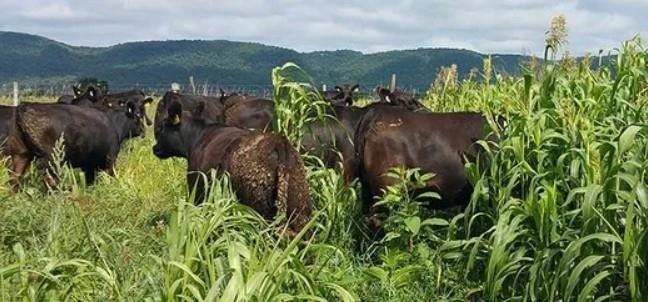By Stan Smith
In a year like this when, according to the National Ag Statistics Service (NASS) estimates, barely half of Ohio’s first cutting hay harvest was completed by mid-June, it is apparent that Ohio cattlemen will again be faced with finding ways to make “feed” from forages that were harvested way past their prime.

Digestibility low quality, long stem forage can be increased 25 to 30% by processing it before feeding.
As an example of the hay quality we are seeing, a recent forage analysis on some Fairfield County mixed grass hay that was mowed in mid-June and baled shortly after shows less than 7% crude protein and less than 40% TDN (total digestible nutrients) on a dry matter basis. I could tell you that’s not good feed, but perhaps a better way is to compare it to wheat straw. Book values I found for the feed nutrient content of wheat straw show a TDN of 43% and crude protein of 4.2% . . . not a lot different than the hay we tested. With so much of Ohio’s first cutting hay being made in late June and even into July this year, it creates a challenging feed quality situation we have experienced far too often in recent years!
Feed of the quality referenced in the forage sample analysis above and fed to cows as long stem hay, even when offered in unlimited amounts, simply will not satisfy the nutritional requirements of a cow in the third trimester of gestation or lactation. Without amendment, feeding this quality of forage results in cows with lesser body condition, poor quality colostrum, delayed return to estrus, lower conception rates, and lighter calf weaning weights. In part this can result from cows not breeding on first service and/or having lower milk production than if they were on an adequate nutritional plane.
Considering that in many parts of Ohio a forage quality problem exists again this year, it’s not realistic to expect we can replace all the poor-quality hay that’s was made this year with only a properly made second or third cutting. It is apparent it will be necessary to find ways to efficiently utilize the lesser quality first cutting hay we presently have. There are options available to accomplish just that, and time to create and implement strategies that allows it without cow health suffering.
As you consider alternatives for efficiently feeding late made, low digestible forages, and stretching the supply of any high-quality forages that might be in inventory, consider this brief checklist:
- Sample, test and inventory each lot of hay that has been made. Similar qualities of hay should be stored together in order that they can be found and fed at the most opportune times throughout the hay feeding season.
- Can bunk feeding cows during the winter months be made an option? This allows for limited supplementation of extra energy and/or protein in the correct amounts and at the correct times.
- Consider processing poor quality, long stem hay into smaller particle size? Reducing the large particle size of mature long stem grass hay to two to 6 inches in length can increase the rate of forage digestion enough that it allows cows to consume 25-30% more forage on a daily basis.
- If forage processing is not an option for you, consider using a prebiotic feed additive that will increase fiber digestibility. The increase in digestion of feedstuffs by supplementation of a prebiotic is the result of increased numbers of ruminal bacteria and the activity of the normally occurring intestinal microflora.
- Optimize the quantity and quality of pasture lands that can be grazed yet this fall or winter. At a minimum, applying 30 to 50 units of additional nitrogen now will create additional high quality forage that can be grazed later this year.
- As soon as possible pregnancy check and eliminate open or unproductive cows. Cull cow values remain high, and high quality forages are a precious commodity that need to be reserved for productive, bred cows.
In the meantime, if Mother Nature has caused you to be dealing with far too much hay of subpar quality, now is the time to assess feed inventory and create a plan for how to effectively and efficiently utilize what you presently have. Calves are and will continue to be into the foreseeable future too valuable to risk their health and performance by mismanaging momma’s nutrition in the coming months.
Source : osu.edu